Clover Forest Plantation
| Clover Forest | |||
|---|---|---|---|
 Clover Forest north porch | |||
 Location within Goochland | |||
| Alternative names | Clover Forest Plantation | ||
| General information | |||
| Architectural style | Federal | ||
| Location | Goochland, VA, United States | ||
| Coordinates | 40°27′11″N 79°55′46″W / 40.4531°N 79.9294°W / 40.4531; -79.9294Coordinates: 40°27′11″N 79°55′46″W / 40.4531°N 79.9294°W / 40.4531; -79.9294 | ||
| Construction started | 1761 | ||
| Design and construction | |||
| Architect | Captain Thomas Pemberton | ||
| Renovating team | |||
| Architect | J. A. Volcker van Soelen | ||
| Renovating firm | Harold Keaton | ||
| Website | |||
| Clover Forest Website | |||
| |||
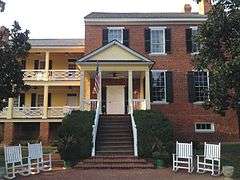
Clover Forest Plantation, located in Goochland, Virginia between Richmond and Charlottesville, is an authentically restored James River estate consisting of terraced landscaped grounds, a private lake, and a Federal-style mansion with portions dating back to pre-revolutionary America. The property lies in a large bend of the James River and forms with the neighboring plantations what is known as the Golden Horsehoe, from East to West: Blythewood, Orapax, Bolling Hall, Pocahontas, Dungeness 1931†, Rockcastle, Deer Lodge, Mannsville†, Bolling Island, Snowden, Clover Forest, Howard's Neck, Harrison's Elk Hill, and Jefferson's Elk Hill†.[1] Since 2003 Clover Forest hosts weddings and receptions and operates as a Bed & Breakfast.
The seating of the land (1714-1761)
In 1714, the land on which Clover Forest stands was first part of the several thousands of acres patented by Charles Fleming which would eventually become the neighboring plantations of Rock Castle, Snowden, Howard’s Neck and the site of Elk Island. It was more land than one man could seat (settle) and portions fell back to the Crown of England. In 1739/1740 Lieutenant Governor William Gooch authorized the sale of 2,590 acres for 13 pounds to John Woodson, Gentleman. John Woodson split the purchase with Joseph Dabbs, but Woodson and Dabbs failed “to make such cultivation and improvements” to the land as required and the land reverted to the crown. In 1745, the land was sold again for 13 pounds to Philip Webber. Philip Webber likewise could not fulfill his obligations and again the land reverted and resold, this time for 11 pounds 15 shillings, to Arthur Hopkins in 1753. Hopkins apparently did better than his predecessors: under his ownership only a portion reverted to the Crown.[2][3]
The Reverend William Douglas (1761-1763)
At last, on August 7, 1761, the Reverend William Douglas and his wife Nicholas [sic] successfully patented 1,134 acres for 4 pounds 10 shillings.[2][3] Either the land was not as devoid of improvements or the Reverend was very active either way twenty months later there were houses and orchards that conveyed with the land when it was sold. Douglas is the famous - at least locally - author of the Douglas Register, a favorite among genealogist with Goochland roots. The Reverend William Douglas was the Church of England minister of the vast St. James Northam Parrish which encompassed today's Virginia counties of Goochland, Fluvanna, Louisa, Orange, and Spotsylvania. The original Dover Church in Goochland, no longer standing, was his “home” church. Being the only legally authorized clergyman Douglas compiled (nearly) all births, marriages, and deaths covering the period from about 1750 to 1797, with some miscellaneous records going back to 1705 that the reverend took upon himself to recreate as there was no register before he came to office.[4] Whether as a his permanent home or just a farm to supplement his income and table, it is not known how the Reverend and his wife Nicholas occupied Clover Forest, they are nonetheless credited with building what is today the oldest section of the house (the lower part of the west wing). Their purchasing of the property in 1761 is seen as the birth of Clover Forest. William and Nicholas Douglas had one Daughter Peggy Douglas who wed Nicholas Merriwether.
Bowler Cocke the younger of Henrico County (1763-1792)
On 19 April 1763, Bowler Cocke the younger of Henrico County became the new landlord and kept the property for almost thirty years. It does not appear that Bowler Cocke made his home in Goochland. At the close of the War for Independence, Cocke refined his holding, selling a portion here buying a little land there, which left him with a continuous track of 898 acres.[3][5][6] Bowler Cocke was an active land speculator as he owned many different tracts of land in and out of Goochland County. Bowler Cocke bought some of the lands granted to the Revolutionary war veterans in Kentucky and Ohio and possibly how he came in contact with Captain Thomas Pemberton.[7]
Captain Thomas Pemberton: (1792-1828)
It is not exactly known where Thomas Pemberton hailed from. Some evidence points to Buckingham County which courthouse burned twice (!) making research there very difficult and some evidence points to King William County.[8]
A. The Officer, Continental Dragoon and Legionaire
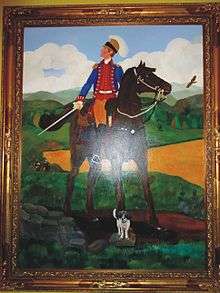
We first find Pemberton when he was commissioned as Cornet in Bland's Virginia Horse later the 1st Continental Light Dragoons on December 5, 1776. (A Cornet is the officer bearing the flag or regimental colors). Thirteen days later he was promoted to Second-Lieutenant, and the regiment soon headed north to join General George Washington at Valley Forge. The Continental Army had very little cavalry and the demands on the Dragoons for scouting, foraging and warfare were intense. Amazingly Pemberton survived the war, making First Lieutenant in 1778, Captain on June 12, 1779, and retiring from the service on November 9, 1782 or January 1783.[9] For his six years of military service to the young nation Pemberton was awarded 4,000 acres in Kentucky on the waters of the North Forke.[10] He was one of the original members of the Society of the Cincinnati in the State of Virginia.[11]
The formation of Bland's Virginia Horse: The Revolutionary Virginia Convention held in May 1776 marked the issuance of the all important resolution to direct Virginia's delegates in Philadelphia to seek independence from the British and form a confederation of the colonies. Such a serious decision required the backing of additional military strength. Virginia Governor Patrick Henry authorized Major-Commandant Theodorick Bland to raise a volunteer battalion. Bland had distinguished himself in the Expulsion of Royal Governor Dunmore. Six months later, when General George Washington needed cavalry to counter that of the British, the Continental Congress on November 25, 1776 requested Virginia transfer Major Theodorick Bland's Light Horse to the Continental Army. While there was reluctance to send the troops away, Virginia acceded to the request. Bland's Light Horse became the 1st Regiment of Continental Light Dragoons. Bland had six troops of cavalry. Each contained 3 officers, 3 corporals, a drummer, a trumpeter, and 29 privates. Three quartermasters provided logistical support for the group. In March of 1777 this 1st Regiment of Continental Light Dragoons — plus the three other regiments — were reorganized, resulting in a slight increase in their numbers. The reorganized regimental headquarters consisted of a colonel, a lieutenant-colonel and a major, who were supported in turn by a staff consisting of a chaplain, a quartermaster, a surgeon and mate, a paymaster, a riding master, a saddler, a trumpet major, an adjutant and 4 supernumeraries—cadets undergoing training who were used as the colonel's messengers. Each troop now consisted of 32 privates, 1 armorer, 1 farrier, 1 trumpeter, 4 corporals, 1 quartermaster sergeant, a drill or an orderly sergeant, a cornet, a lieutenant, and a captain—a total of 280 men and officers. Whether any of the four regiments of Dragoons was ever at full strength is uncertain.[12][13] So at the very best in 1777 there were 1120 dragoons in the continental army—the Continental Congress had authorized 3000—officers aside there were no other mounted troops in the whole continental army, fortunately for the Americans the English with their 16th Queen's Lancers and 17th Regiment of Dragoons did no better.[14] The star that would emerge from the 1st Continental Dragoon was Light Horse Harry Lee who gained national fame at the Battle of Paulus Hook and in the Southern Campaign, Pemberton does not appear in the memoirs.[15]
The 2nd Continental Light Dragoons hailed from Connecticut and was well led by Elisha Sheldon. It fought with distinction, whether mounted or unmounted, and at war's end had 225 men. Like Thomas Pemberton's 1st Regiment, the 3rd Regiment—"Lady Washington's Dragoons"—was also from Virginia. The 3rd was commanded by Lieutenant-Colonel George Baylor and seconded by Major Alexander Clough, one of George Washington's spies. The 3rd was the victim of a heinous act of war when they were attacked in their billet and refused quarter in 1778. The 4th and final regiment drew its membership from Pennsylvania, Maryland, Virginia, and New Jersey. The 4th suffered great losses at the battle of Camden.
Thomas Pemberton rose to captain in the 1st Regiment of Continental Light Dragoons on June 12, 1779 after the Regiments transfer from the Main Continental Army to the Southern Department on November 8, 1778. All four regiments evolved from light dragoons units to legions that combined mounted and foot units. The 1st, 3rd and 4th eventually merged and fought together in one unit of four troops under the command of Colonel William Washington (cousin of the General) officially named the 1st Legionary Corps on January 1, 1781. The First, as Dragoon and Legion, fought in Northern New Jersey, protected Philadelphia, survived the siege of Charleston 1780, fought with Lafayette in Virginia and at Yorktown, defended the Carolinas in Nathaniel Greene's Campaign.[16]
B. Pembertons of Goochland
In 1792 (exact records have not survived) Captain Thomas Pemberton and his wife Dice acquire the plantation which they will name Clover Forest. In 1795 they sell the 4000 acres of Kentucky bounty lands Pemberton had been awarded for his service in the continental army to Bowler Cocke. In 1807 Pemberton builds out of brick what is today the main part of the house. Over an English basement the parlor, the master bedchamber (today the dining room) two large rooms and an annex and a large attic room under the rafters. On one of the chimney is brick dated 1811, marking the completion of the construction. All the wood work in the Parlor, the Hall and staircase and most of the dining room, dates to this period. Of particular interest are the mantles in the dining room and parlor. On one the seal of the United States commemorates Pemberton's service to the young Nation now at peace the eagle's head turned to the olive branch, on the other agricultural implements symbolizing, like Cincinnatus, Pemberton's return to agricultural pursuits after having defended the nation.
-

The seal of the United States commemorates Captain Pemberton's service, dining room fireplace.
-

Detail of the Clover Forest mantel showing the Eagle of the United States commemorating Captain Thomas Pemberton's service in the Continental Army.
-

Detail of the Clover Forest mantel showing the agricultural implements symbolizing Captain Thomas Pemberton's return to agrarian endeavors after saving the nation with his fellow revolutionary veterans like the Roman hero Cincinnatus.
-

Anne Coleman Pemberton Crenshaw, said to be copy of a painting by Thomas Sully, Picture courtesy of Dave and Nancy Brown.
Three generations of Pembertons would live at Clover Forest making them Clover Forest's longest living family. Captain Thomas Pemberton and his wife Dice had six children who lived to adulthood, four daughters and two sons: Ann Coleman (married Ashburry Crenshaw, April 1810), Dice King (married Isaac Quarles, Jr., August 4, 1814), Mary B. (married Archibald Bryce, on January 16, 1811) and Maria A. (married John A. Selden, on August 24, 1823), John B. (married Mary Louisa Gilliam, daughter of John Gilliam, on February 7, 1829) and Thomas Jr. (married Lucy Jane Scott, daughter of Thomas Scott, on May 1, 1828).
Captain Pemberton was a Church Warden for the Lickinghole Episcopal Church, on Lickinghole Creek where he helped straighten out the property deed of the Church.[17] He was a representative of the "Cartersville Bridge Company" in trying to mediate the conflict between the first Cartersville Bridge (Chartered 1818, finished 1821) and Randolph Harrison's competing Ferry who was offering crossings at a lower toll rate.[18] The mediation was not successful the conflict between bridge and ferry went all the way to the Virginia Supreme Court, long after Pemberton's passing.[19]
Captain Thomas Pemberton died on October 4, 1828, a few months after having obtained a pension for his military service. As Dice Pemberton is not mentioned in her husband’s will, it is believed she passed before her husband. They are both thought to be buried in the Pemberton family cemetery on the grounds of Clover Forest Plantation, specifically in the two graves without headstones that were at one point visible.[20]
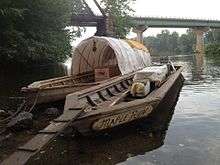
C. Pemberton, the Village
The Village of Pemberton: Named for the Pemberton family of Clover Forest Plantation, now barely a hamlet overlooking the James River was once a hub of activity. A dam and canal lock had been built on the James at Pemberton. The lock lowered boats from the Kanawha Canal into the James River just below Cartersville, Cumberland County, Virginia and connected with Tamworth, Virginia and its Mill and the trade the Cartersville port and from the Willis River. In addition to the canal and river, Pemberton was also accessible via the Cartersville-Fredericksburg State Road that began in Cartersville, crossed the James, and continued northward. The Cartersville Bridge, built across the James River in 1824, connected Cartersville (Cumberland County) and Pemberton (Goochland County) and was the first James River bridge for Goochland County; all other crossings were by ferry at that time. In the late 1800s when the Richmond-Allegheny Railroad (later the Chesapeake & Ohio Railroad, and currently CSX) was built on the tow path of the abandoned Kanawha Canal, Pemberton was one of the railroad stops with trains arriving daily carrying passengers and mail. By the early 1920s Pemberton was a thriving community consisting of a large combined general store and post office, a lumber mill and pulp yards. Several prominent Goochland County residents lived in Pemberton: William Henry (Bill) Hall, a veteran of the War Between the States, spent his last years here. Bland Selden Hobson, the only Goochland woman known to have served overseas in World War I, was also a Pemberton resident.[21]
John B. and Mary Louisa Gilliam Pemberton: (1828-1873)
John B. Pemberton eldest son of Captain Thomas Pemberton (Born May 13, 1803, Died at Clover Forest Dec. 9th 1848) married Mary Louisa Gilliam on February 7, 1829, John's father passed later that same year. They had five known children, four lived to adulthood Polly, Thomas, Virginia and Richard. Mary Louisa Gilliam Pemberton was the last of the Pembertons to live at Clover Forest. She died in 1873 at age 69 ending the 81 year tenure, to date, the Pembertons are still the longest lived family at Clover Forest. Mary Louisa is buried in the Pemberton family cemetery on the grounds of Clover Forest Plantation with her husband and her son John (born March 5, 1835) who died on Christmas day 1839 at age four.[22]
-

Pemberton Cemetery Gate
-

Sacred, to the memory of, John B. Pemberton, eldest son of, Capt. Thomas Pemberton, of Goochland, Born May 13, 1803, Died at Clover Forest, Dec. 9th 1848.
-

John 4 years old died Christmas Day: Sacred to the memory of, John, son of, John B. and Mary L., Pemberton, Born March 5, 1835, Died Dec., 25 1839.
-

Mary Louise Gilliam, Wife of, John B. Pemberton, Born Dec. 6, 1803, Sept. 15, 1873.
William H. and Sally Parrish (1884-1903)
The succession of John B. Pemberton was a bit of a mess due to debt. Creditors won a Chancery suit in 1870 and John Colton bought Clover Forest. By all appearances Mary Louise Gilliam Pemberton was permitted to stay. John Colton defaulted on his payments and in 1879 a decree for resale was imposed. William H. Parrish bought the 900 plus acres that composed Clover forest in 1881 which was legally conveyed to him in 1884. In 1882, William H. Parrish also bought 790.5 acres of Howard's Neck Plantation which bordered on Clover Forest.[20][23][24]
The Boggs, the Pearcys and the Witcamps (1915-1949)
The Boggs the Pearcys and the Witcamps are all one family, a large one at that, and it gets a bit hairy to figure out who owned what between Boggs selling to Pearcy, Pearcy to Boggs, inheritances to Pearcys.[25] The oral history is a bit simpler and as all oral histories to be taken with a grain of salt. Two brothers Boggs, hailing from West Virginia with family money from coal and oil bought the adjoining properties of Clover Forest and Snowden.
Richard S. and Margarite Louise Holson (1949-1967)
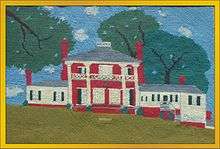
The Holsons were a couple from Chicago, who purchased Clover Forest both as their vacation home and as a working farm which operated as "Independence Operations, Inc." In 1962 the land holdings were enlarge by the acquisition of the low grounds of Bolling Island.[26] Louise had been Richard's secretary before becoming his second wife. Louise charmed the locals, it was a special treat to be invited to visit her rose garden recalled Roselle Scales from Fife or to be invited to her parties. Dr. Richard Couture of Bolling Island remembered Louise being able to serve any drink one could think of. Louise did not like being by herself at Clover Forest so she always made sure a staff person would stay with her at night.
The Holsons thought big, everything was brought in from Chicago, a few items remain to this day, such as the kitchen cabinets and the old gas crystal chandelier in the dining room. To Farm Manager, Bud Engel, also from Illinois, fell the task of making everything happen. The undertaking was massive in addition to running a large modern cattle and hog operation big things were happening to Clover Forest. It is likely that most of the outbuildings and former slave quarters were removed at this time. Where the outhouse had once stood a three car carriage house came into being. To balance out the house the east side porch and root cellar were removed and the library wing was added to the house. Through some creative plumbing (which would have to be straightened by later owners) the bedrooms were equipped with bathrooms.
The existing terraces were augmented, a massive dam was laid across the creek to form a 7 acre lake. The Dam had to be made bigger than originally intended as an additional spring was uncovered near the dam site.[27] A three hole golf course and Mrs. Holson's rose garden was laid out and tended by three full time gardeners. Pickett Pannel (sp?) was the head gardener and was most dedicated, tirelessly making sure the garden looked great in all seasons, he also was the black community's undertaker, Buddy Cave was chiefly in charge of the maintenance of golf course.[28]
When the Holsons sold, Bud Engel remained in Virginia and him and his son Kevin Engel run Engel Farms, working over ten thousand acres and a even land that once was part of "Independence Operations, Inc."

Floyd Dewey Gottwald, Sr. (1967-197?)
Floyd Dewey Gottwald, Sr was the Chairman of Ethyl Corp., he bought Clover Forest, and at the same time acquired the nearby plantation of Snowden from Fred and Virginia Fleischman by trading Snowden for Contention Plantation further East but still in Goochland.[29] The whole was operated under the name of "Snowden Corporation".
Mr. Robert Lee Johnson (February 13, 1920- August 1979)was the Farm Manager and Mr. Steve Lawson Sr. was the Swine Manager. Mr. Johnson was orphaned at age 6 but was adopted with another boy by John Albert and Ida Jenkins who had a small chicken farm near Cartersville, VA. Robert married Ruby Janet Johnson (1919-). Before working for Snowden Corporation Mr. Johnson had been the farm manager for the Snead Dairy Farm (Present day Willow Oaks).[30]
Mr. Gottwald was enthusiastic about the history of the property and he loved tramping all over his land, when William E. Trout III told him about the "Cartersville Connection" the short canal and lock that connected the Kanawah Canal to the James River and the Cartersville Port, Mr. Gottwald had the Connection promptly excavated revealing it in near perfect condition.[31]
Mr. Gottwald left a huge mark by creating a 67 acre lake off of Whittcamp Road by damming Pickett's Creek, also known as Fleming's Park Creek. There was a Mill on the creek at one time. Joe Scales was enlisted for the engineering of the dam, it was the largest private lake project in Goochland.
The Gottwalds gathered their family at Clover Forest every Thanksgiving but lived in the Richmond neighborhood of Windsor Farms. It is said that Mrs. Gottwald never fell in love with Clover Forest nor Snowden and thus the property lost appeal for Mr. Gottwald. Snowden Corporation was bought by an Attorney who was not able to make it work for him and sold it to a land speculator who dispersed all he could.
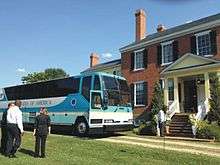
Clover Forest Today (1978-Present)
Mr. Johnson remained the Farm Manager until his passing in 1979 and was succeeded by Jimmy W. Jones, who remained until he retired in 2001. The Clover Forest Plantation continues to operate as a farm though on a much smaller scale with a flock of sheep and tenant cattle. Most of the land found new owners who farm it with the help of Engels Farm. The Clover Forest Mansion operates since 2003 as Clover Forest Plantation a Bed and Breakfast and special events venue and added Clover Forest Catering in 2004.
Bibliography
Bullard, CeCe (1994). Goochland Yesterday and Today. Goochland County Historical Society.
Farrar, Emmie Fergusson; Hines, Emilee (1974). Old Virginia Houses, The Heart of Virginia. Hale Publishing.
Hudgins, Dennis (1996). Goochland County Plat Number Index to the Surveys in the Virginia Land Office Patent and Grant Books. Goochland County Historical Society Magazine, XXVIII.
Loescher, Burt Garfield (March 1954). Bland’s Virginia Horse: The Story of the First Continental Light Dragoons. Journal of the Company of Military Collectors & Historians, Vol. VI, No. 1.
Miner, Robert G. (1977). Survey of Early American Design. Arno Press Inc.
Trout, III, William E. (1994). The Slate and Willis's Rivers Atlas. The Virginia Canals & Navigations Society, Incorporated.
Weeks, Elie (1973). Clover Forest. Goochland County Historical Society Magazine, B-1.
Wright Jr, Robert K. (1983). The Continental Army. Center of Military History, United States Army.
References
- ↑ CeCe Bullard, Goochland Yesterday and Today, Goochland County Historical Society, 1994 pp. 113-137
- 1 2 Land Patent Book 33 p. 1107 (Virginia State Library)
- 1 2 3 Elie Weeks, “Clover Forest” Goochland County Historical Society Magazine 5-A, 1973 p. 7.
- ↑ William Douglas, William MacFarlane Jones: The Douglas Register: Being a Detailed Record of Births, Marriages, and Deaths, Together with Other Interesting Notes, as Kept by the Rev. William Douglas from 1750 to 1797; an Index of Goochland Wills; Notes on the French-Huguenot Refugees who Lived in Manakin-town Genealogical Publishing Com, 1966
- ↑ Goochland Deed Book 14,15 June 1787, p. 438
- ↑ Goochland Deed Book 16, 5 February 1791, p. 55
- ↑ Elie Weeks, “Clover Forest” Goochland County Historical Society Magazine B-1, 1973 p. 7.
- ↑ Elie Weeks, “Clover Forest” Goochland County Historical Society Magazine B-1, 1973 p. 9.
- ↑ Burt Garfield Loescher, Washington's eyes: The Continental Light Dragoons, Old Army Press, 1977, p. 123.
- ↑ Some records show 4,666 acres but that is a missread of the zeros on the original document.
- ↑ John Cropper, List of original members of the Society of the Cincinnati in the State of Virginia (1896)
- ↑ Robert K. Wright Jr. The Continental Army, Center of Military History, United States Army, 1983, p.107 p.128
- ↑ Burt Garfield Loescher, Washington's eyes: The Continental Light Dragoons, Old Army Press, 1977.
- ↑ Robert K. Wright Jr. The Continental Army, Center of Military History, United States Army, 1983, p.93 p.106
- ↑ Robert E. Lee editor, The Revolutionary War Memoirs Of General Henry Lee Da Capo Press, 1998
- ↑ Burt Garfield Loescher: Bland's Virginia Horse: The Story of the First Continental Light Dragoons in Journal of the Company of Military Collectors & Historians, Washington D.C., March 1954, vol VI no 1 pp 1-6.
- ↑ Helène Barret Agee, Facets of Goochland (Virginia)County's History, The Dietz Press, Incorporated, Richmond Virginia, 1962, p. 120.
- ↑ William E. Trout, III, The Slate and Willis's Rivers Atlas, The Virginia Canals & Navigations Society, Incorporated, 1994 p. 42
- ↑ Cases Decided in the Supreme Court of Appeals of Virginia, Volume 38, 1841, pp. 544-555
- 1 2 Elie Weeks, “Clover Forest” Goochland County Historical Society Magazine 5-A, 1973 p. 13.
- ↑ Melinda Brooking Gammon, "Looking Back: Pemberton once was a hub of activity," Goochland Gazette
- ↑ Elie Weeks, “Clover Forest” Goochland County Historical Society Magazine 5-A, 1973 p. 10.
- ↑ Goochland Deed Book 44, p. 667.
- ↑ Elie Weeks, “Clover Forest” Goochland County Historical Society Magazine 5-A, 1973 p. 11.
- ↑ Goochland Deed Book 59, p. 141.
- ↑ Richard Couture, “Bolling Island” Goochland County Historical Society Magazine 4-B, 1972 p. 30
- ↑ Scales, Joe, engineer. Recollections of Joe collected by Sebastian Volcker
- ↑ Pleasants, James "Spanky", of Blanton & Pleasants General Store, son in law to Mr. Johnson (see below). Recollections collected by Sebastian Volcker
- ↑ Elie Weeks, “Snowden” Goochland County Historical Society Magazine III B, Autumn 1971 p. 26.
- ↑ Pleasants, June Janet Johnson. Recollections collected by Sebastian Volcker
- ↑ William E. Trout, III, The Slate and Willis's Rivers Atlas, The Virginia Canals & Navigations Society, Incorporated, 1994 p. 40
External links
| Wikimedia Commons has media related to Clover Forest Plantation. |